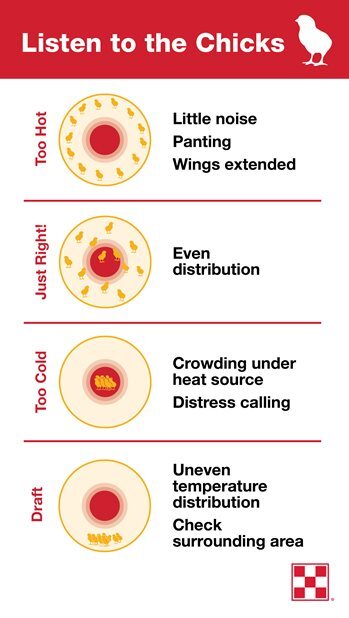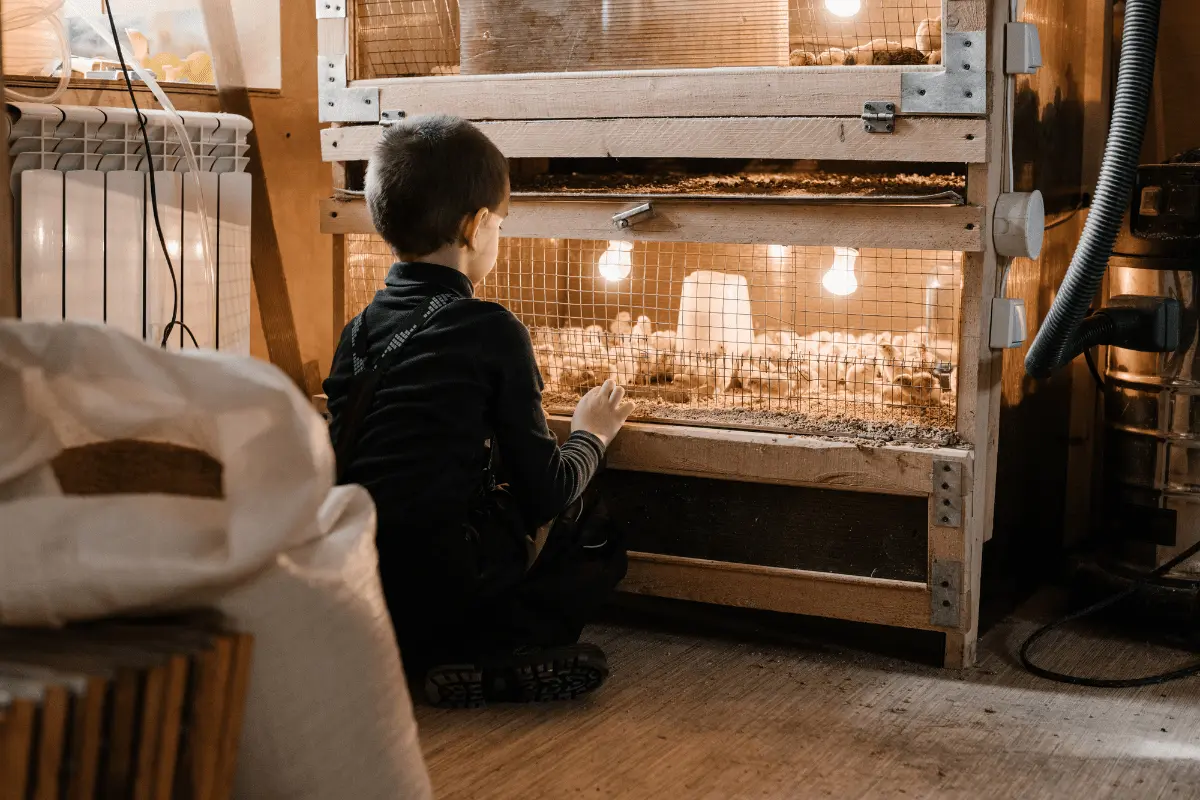If you’re new to this exciting adventure of raising chicks in your very own chick brooder or looking for some expert tips, this blog will help you with that.
In this detailed post, we’ll walk you through everything you need to know about setting up and caring for your fluffy little chick friends in their cozy brooder.
Table of Contents
What is a Chick Brooder?
A chick brooder is like a warm, safe haven for baby chicks, providing them with the ideal environment to thrive during their early days. Think of it as their own comfortable nursery where they can eat, drink, sleep, and grow without any worries. This specially designed space mimics the warmth and protection that mother hen would offer in nature.

The main purpose of a chick brooder is to create a controlled microclimate for the chicks, maintaining optimal temperature and humidity levels essential for their health and development. It helps them stay warm, encourages healthy growth, and protects them from drafts or predators.
Equipped with heat sources, bedding materials, feeders, waterers, and proper ventilation systems – a chick brooder ensures that these little ones have everything they need right at their tiny beaks.
The Benefits of Raising Chicks in a Brooder
Raising chicks in a brooder comes with a plethora of benefits that contribute to their health and well-being.
i) Warm & Safe – The controlled environment ensures that the chicks are kept warm and safe during their crucial early days.
ii) Monitor Food Intake – The environment also helps in monitoring their food intake, hydration levels, and overall development.
iii) Minimizes Risk of Predators – Using a brooder minimizes the risk of predators or adverse weather conditions affecting the vulnerable chicks. It gives them a secure space where they can grow without external threats looming over them.
iv) Closer Observation – Being raised in a brooder facilitates easier access for daily check-ups and care routines, allowing for closer observation of each chick’s progress.
Utilizing a brooder creates an optimal environment for your chicks to thrive and flourish as they transition into healthy poultry birds ready for life outdoors.
Choosing the Right Location
Choosing the right location for your chick brooder is crucial for the health and well-being of your chicks.
i) Away from Direct Sunlight – Ideally, you want to place the brooder in a draft-free area away from direct sunlight or extreme temperatures. A garage, shed, or spare room can make excellent locations.
ii) Access to Essentials – Ensure that the chosen spot has access to power outlets for heat lamps and other essential equipment. It’s important to have easy access to water sources as well.
iii) Surface Level – Consider placing the brooder on a level surface that is easy to clean and disinfect regularly. This will help maintain a hygienic environment for your chicks.
iv) Safety – Keep in mind that proximity to potential predators should also be taken into account when selecting a location for your chick brooder. Safety should always be a top priority.
By carefully choosing the right location for your chick brooder, you are setting up for a successful growth of your.
Essential Equipment and Supplies Needed
When setting up a chick brooder, having the right equipment and supplies is crucial for the health and well-being of your chicks.
Here are some essential items you’ll need to create a safe and comfortable environment for your feathered friends.
i) Brooder Box – You’ll need a brooder box or pen to contain the chicks. This can be as simple as a cardboard box or as elaborate as a commercial brooder setup. Make sure it’s spacious enough to allow room for growth but cozy enough to provide warmth.
ii) Heat Source – You’ll need a heat source such as a heat lamp or heating plate to mimic the warmth of a mother hen. Temperature control is key in ensuring that your chicks stay healthy and thrive.
iii) Bedding Material – Bedding material like pine shavings or straw will provide comfort for the chicks while also absorbing droppings and moisture. It’s important to keep the bedding clean and dry to prevent any potential health issues.
Don’t forget about feeders and waterers designed specifically for chicks. These should be easily accessible and kept clean to promote good hygiene practices among your flock.
Setting Up the Brooder: Step-by-Step Guide
Let’s dive into the step-by-step guide on how to create the perfect brooder for your little ones.
- First things first, choose a suitable container like a cardboard box or a plastic tub. Make sure it’s large enough to accommodate your growing chicks comfortably.
- Line the bottom of the brooder with pine shavings or paper towels for easy cleaning and good insulation. Avoid using newspaper as it can be slippery and not very absorbent.
- Next, install a heat source such as a heat lamp or heating pad to maintain an optimal temperature of around 95°F in one corner of the brooder. This will keep your chicks warm and happy.
- Provide fresh water in shallow containers that are easily accessible to prevent drowning accidents. Also, scatter chick feed on clean surfaces to encourage pecking behavior and proper nutrition intake.
- Monitor the temperature regularly and adjust as needed. Keep the brooder clean by changing bedding frequently and ensuring good ventilation for healthy chick development. Happy brooding!
Caring for Chicks in the Brooder
Raising chicks in a brooder requires attentive care to ensure their well-being and growth. Regularly check the temperature inside the brooder to make sure it’s within the recommended range for your chicks’ age. Ensure they have access to clean water at all times, as dehydration can quickly become an issue.
Feeding your chicks a balanced diet is crucial for their development. Provide them with chick starter feed containing essential nutrients like protein and vitamins. Keep their bedding clean and dry to prevent any health issues or discomfort.
Handling your chicks gently helps them feel secure and builds trust with you as their caregiver. Spend time observing them daily to monitor their behavior and health closely. Any signs of illness should be addressed promptly by contacting a veterinarian who specializes in poultry care.
Creating a safe, warm, and nurturing environment in the brooder will set your chicks up for success as they grow into healthy adult chickens.
Common Challenges and How to Overcome Them
Raising chicks in a brooder can come with its own set of challenges, but fear not, as many poultry enthusiasts have faced similar hurdles and found solutions along the way.
One common challenge is maintaining the right temperature. Chicks are sensitive to extreme temperatures, so it’s essential to monitor and adjust the heat source accordingly. A simple solution is to use a thermometer and gradually increase or decrease the heat lamp’s height until you find the perfect balance.
Another issue that may arise is overcrowding. It’s easy to get carried away with adding more chicks than your brooder can comfortably accommodate. To overcome this challenge, ensure there is enough space for each chick to move around freely without feeling cramped.
Health concerns like pasty butt can also surface during chick rearing. This condition occurs when droppings stick to a chick’s vent area, potentially leading to infection if not addressed promptly. Regularly check and clean each chick’s vent area to prevent this issue from escalating.
By being proactive and attentive to these common challenges, you’ll be better equipped to provide a safe and nurturing environment for your growing chicks in the brooder!
Moving Chicks to a Coop: When and How to Do It
Congratulations! Your chicks have grown and are ready to move out of the brooder into their coop. But when is the right time to make this transition? Typically, chicks can be moved to a coop around 6-8 weeks of age, or once they are fully feathered and can regulate their body temperature efficiently.
Before moving them, ensure that the coop is predator-proof, well-ventilated, and equipped with bedding material for warmth and comfort. Introduce your chicks gradually to their new environment by allowing them supervised access at first before leaving them overnight.
Keep an eye on how they adjust – if they huddle together too much or seem stressed, provide additional heat sources like heat lamps temporarily. Remember to offer fresh water and food in their new space to encourage exploration and settling in comfortably without disruptions.
Moving your chicks from the brooder to a coop marks an important milestone in their growth journey. By following these steps thoughtfully, you can ensure a smooth transition for your happy flock!
Tips for Maintaining a Clean and Healthy
Remember, maintaining a clean and healthy environment for your chicks is crucial for their well-being. Regularly clean the brooder, change bedding as needed, provide fresh water daily, and ensure they have access to nutritious food. Additionally, keep an eye on their behavior and health status to catch any issues early on.
By following this complete guide on how to set up a chick brooder, you’ll be well-equipped to raise happy and healthy chicks from day one. Enjoy the rewarding experience of watching them grow into strong chickens ready to thrive in their coop!
